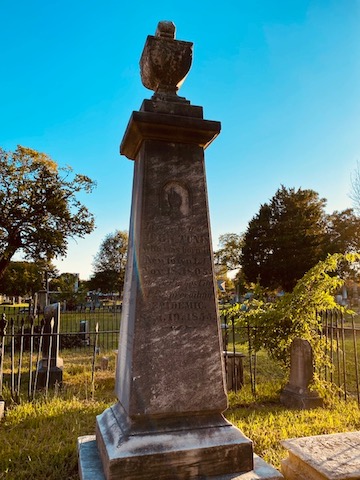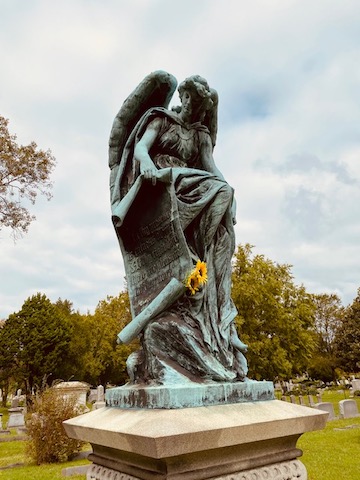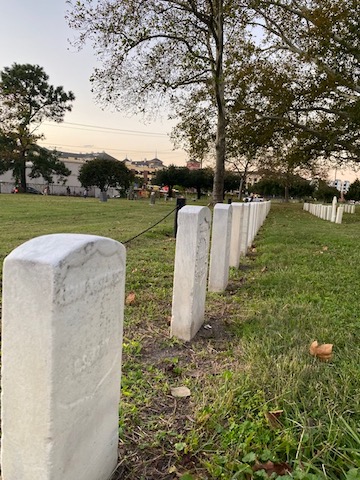If you’ve never experienced a cemetery tour, Norfolk is the city in which to start. The historic cemeteries, many filled with beautiful Victorian funerary art, provide a glimpse into the past and insight into some of the notable people who shaped Norfolk into what it is today. The city is home to eight historic municipal cemeteries: Calvary Cemetery, Cedar Grove Cemetery, Elmwood Cemetery, Forest Lawn Cemetery, Hebrew Cemetery, Magnolia Cemetery, Riverside Memorial Park Cemetery and West Point Cemetery. These cemeteries are honored and educational places offering cultural and recreational resources for Norfolk’s community.
The Norfolk Society for Cemetery Conservation (NSCC) offers an array of captivating tours led by NSCC volunteers, knowledgeable historians and experienced storytellers, helping to bring the stories to life. They also host an annual “From Here to Eternity” 5K run through several of the cemeteries to raise funds for conservation efforts (the 2024 event is set for 2:30 p.m. on Oct. 12). Learn more about Norfolk’s cemeteries below, with information from the Norfolk Society for Cemetery Conservation.
Calvary Cemetery
Calvary Cemetery was established in 1877 as a burial ground for Norfolk’s African American citizens. For nearly a century, most of Norfolk’s African American citizens were buried at Calvary as there were no other options available to African Americans in Norfolk until the mid-1970s. Epitaphs document the lives of every level of African American society from doctors and lawyers to sailors and laborers. Today, Calvary serves as both a place of remembrance and a chronology of the many important contributions of Norfolk’s African American citizens to the history of our great City.
Cedar Grove Cemetery

Cedar Grove Cemetery was established in 1825 as Norfolk’s first public burial ground. Though it encompasses only 14 acres of land, Cedar Grove is a valuable cultural landscape. Along with many of Norfolk’s founding fathers, there are hundreds of Civil War soldiers and sailors laid to rest at Cedar Grove. It is also the site of mass burials of Norfolk citizens who were victims of the 1855 yellow fever epidemic.
Elmwood Cemetery

Elmwood Cemetery, established in 1853, is a Victorian Garden Cemetery and the final resting place for hundreds of Civil War soldiers, many of Norfolk’s founders and Virginia Governor Littleton Waller Tazewell (1774–1860). Elmwood offers several tours throughout the year. For 2024, the NSCC is leading haunted tours on Oct. 18 and 26 at 2 p.m.
Forest Lawn Cemetery
Forest Lawn Cemetery was established in 1906 as the last of eight municipal cemeteries in Norfolk. The Langley Family Burial Ground was included in this purchase and remains a historical point of interest today with interments dating back to the 1700s. Forest Lawn boasts several fraternal and memorial lots including the Seaman’s Friend Society Lot and the U.S. Army’s 111th Field Artillery Batallion and 29th Infantry Division Memorial. Comprised of more than 165 acres of land, Forest Lawn Cemetery is a natural arboretum with over 70 species of trees including crape myrtles, black walnut trees, dogwoods, and magnolias.
Hebrew Cemetery
Hebrew Cemetery was established in 1850 when prominent Jewish families purchased a rectangular plot fronting Princess Anne Road and extending northeastward. At some point, the surviving graves from Tidwater’s first Jewish burial ground, Power Point Cemetery in Berkley, were transfered to this land.
Magnolia Cemetery
Magnolia Cemetery was established in 1860 and was operated by a private cemetery corporation until the City of Norfolk purchased it in 1911. The cemetery lies in the Berkley section of Norfolk, one of the oldest communities in Virginia.
Riverside Memorial Park
Riverside Memorial Park was established in 1910 in the Campostella Heights area of Norfolk. The City of Norfolk purchased it in 1971. Riverside covers more than 44 acres and has a unique design, like the spokes of a wheel extending outward from a central circle creating sections shaped like pie slices. Since 1995, over 200 trees have been planted at Riverside as part of an ongoing urban forestry program. Tugboats, industrial cranes and other seafaring structures provide the backdrop to several sections at Riverside Memorial Park reminding those who visit of the importance of the ship repair industry to the City of Norfolk.
West Point Cemetery

Though the Norfolk Common Council authorized the burial of “people of colour” in a Potter’s Field in Norfolk in 1827, it wasn’t until 1873 that another Potter’s Field was established for the exclusive interment of African American citizens. Known briefly as Calvary Cemetery, this burial ground was located at the west point of Elmwood Cemetery. In 1885, with the urging of Norfolk’s first African American Councilman, James E. Fuller, Norfolk City Council changed the name to West Point Cemetery. Councilman Fuller further insisted that a section of the cemetery “…be dedicated as a special place of burial for black Union veterans…” Thus, Section 20 was “donated to the Directors of the Union Veterans Hall Association for the burial of the members of the Grand Army of the Republic.”